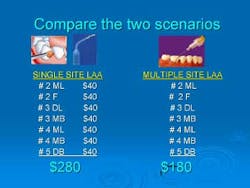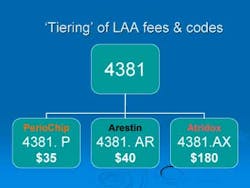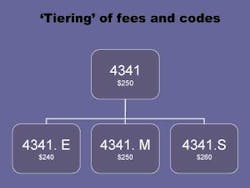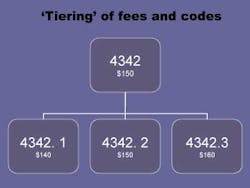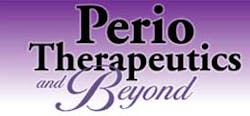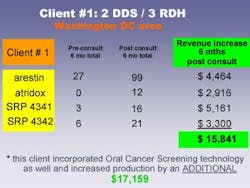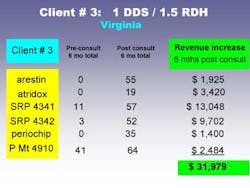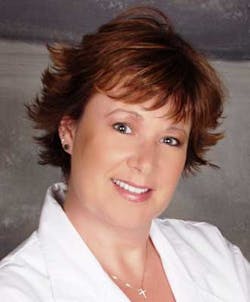By Colleen Rutledge, RDH
The economic climate has affected everyone and dental practices have not gone unscathed. Many hygienists’ hours are being cut back; while their dentist /employers deal with voids in the schedule and a notable loss in the hygiene production. Read more to discover some sure fire ways to jump start your hygiene department by offering non-surgical periodontal services, thus transforming your hygiene department from a “loss leader” into a production leader.Incorporate locally-applied antimicrobials
The locally-applied antimicrobials discussed in this article are all FDA approved biodegradable, bioadhesive and require no refrigeration.(1) They are indicated in periodontal pockets 5 mm or greater and can be used as an adjunct in initial periodontal therapy or during periodontal maintenance. PerioChip, Arestin, and Atridox target periodontal pathogens in a periodontal pocket and are the most well known locally-applied antimicrobials. (2,3,4) Many clinical factors are considered when choosing an antimicrobial. Having said that, consider the cost to the patient in the scenarios below.*
The economic climate has affected everyone and dental practices have not gone unscathed. Many hygienists’ hours are being cut back; while their dentist /employers deal with voids in the schedule and a notable loss in the hygiene production. Read more to discover some sure fire ways to jump start your hygiene department by offering non-surgical periodontal services, thus transforming your hygiene department from a “loss leader” into a production leader.Incorporate locally-applied antimicrobials
The locally-applied antimicrobials discussed in this article are all FDA approved biodegradable, bioadhesive and require no refrigeration.(1) They are indicated in periodontal pockets 5 mm or greater and can be used as an adjunct in initial periodontal therapy or during periodontal maintenance. PerioChip, Arestin, and Atridox target periodontal pathogens in a periodontal pocket and are the most well known locally-applied antimicrobials. (2,3,4) Many clinical factors are considered when choosing an antimicrobial. Having said that, consider the cost to the patient in the scenarios below.*
* Fees are based on approximate national averagesIt is obvious that the better choice for the patient would be to choose a multiple site locally-applied product. Adding Atridox would not only increase patient compliance and yield great clinical results, but it would dramatically increase hygiene production. *See additional case studies below"Tiering" of fees & codes
As a hygiene consultant I recommend the above products, as they all have a unique place in a non-surgical periodontal therapy program. Yet, there is still only one code designated for a locally applied antimicrobial: D4381. I recommend creating a "house code” and separate fee for each product. This provides a means of tracking how much of each product is being used and by which provider. Consider the chart below*:
As a hygiene consultant I recommend the above products, as they all have a unique place in a non-surgical periodontal therapy program. Yet, there is still only one code designated for a locally applied antimicrobial: D4381. I recommend creating a "house code” and separate fee for each product. This provides a means of tracking how much of each product is being used and by which provider. Consider the chart below*:
* Insurance companies do not consider anything past the first four numbers * Fees are based on approximate national averagesPerio Services: Codes in the 4000’s
Hygiene departments thrive and production increases when the "4000’s codes" are used routinely.(5,6,8) In order to see where your practice stands, refer to a production analysis report. You can quickly see how frequently “codes in the 4000’s are being used (note: even though D4355 is in the 4000’s it is NOT a perio code).(6) Utilizing existing ADA codes develop ‘house codes’ to distinguish various periodontal therapy services. There are currently only two codes that describe different degrees of periodontal involvement based on the number of teeth per quadrant: • D4341 - Scale and root plane 4 or more teeth • D4342 - Scale and root plane 1 to 3 teeth Let’s first consider D4341. By CDT definition we know that four or more teeth are affected by periodontal disease. (9) As clinicians, we know that each patient exhibits varying degrees of difficulty - labeled as E: early, M: moderate and S: severe.(8) Consider the chart below*:
Hygiene departments thrive and production increases when the "4000’s codes" are used routinely.(5,6,8) In order to see where your practice stands, refer to a production analysis report. You can quickly see how frequently “codes in the 4000’s are being used (note: even though D4355 is in the 4000’s it is NOT a perio code).(6) Utilizing existing ADA codes develop ‘house codes’ to distinguish various periodontal therapy services. There are currently only two codes that describe different degrees of periodontal involvement based on the number of teeth per quadrant: • D4341 - Scale and root plane 4 or more teeth • D4342 - Scale and root plane 1 to 3 teeth Let’s first consider D4341. By CDT definition we know that four or more teeth are affected by periodontal disease. (9) As clinicians, we know that each patient exhibits varying degrees of difficulty - labeled as E: early, M: moderate and S: severe.(8) Consider the chart below*:
* Insurance companies do not consider anything past the first four numbers * Fees are based on approximate national averagesNext, we will consider D4342 in the same way. By CDT definition we know that up to three is affected by periodontal disease.(9) Simply stated you can classify these as 1, 2, and 3 - identifying how many teeth in each quadrant are involved.(8) Consider the chart below*:
* Insurance companies do not consider anything past the first four numbers * Fees are based on approximate national averagesImpact of incorporating non-surgical therapies: A Case Study
Dental Economics® featured an article by practice management consultant Linda Miles which profiled one of her clients.(7) This 2 DDS/3 RDH practice was experiencing stagnant hygiene production. After implementing Linda’s practice management program they increased by $10,000 per month, but were still lacking in the amount of periodontal services. After implementing a non-surgical periodontal therapy program (8) this practice now has four fulltime hygienists (16 days per month each) and averaging over $84,000 per month (up from $54,000 per month)! This is an excellent illustration of how adding non-surgical procedures not only increase the quality and variety of services, but dramatically affects production.Many dental offices across the country are struggling to make ends meet and keep their hygienists busy. Make a commitment to yourself, your practice and your patients to update the quality and variety of non-surgical periodontal services and watch your hygiene department grow!
Dental Economics® featured an article by practice management consultant Linda Miles which profiled one of her clients.(7) This 2 DDS/3 RDH practice was experiencing stagnant hygiene production. After implementing Linda’s practice management program they increased by $10,000 per month, but were still lacking in the amount of periodontal services. After implementing a non-surgical periodontal therapy program (8) this practice now has four fulltime hygienists (16 days per month each) and averaging over $84,000 per month (up from $54,000 per month)! This is an excellent illustration of how adding non-surgical procedures not only increase the quality and variety of services, but dramatically affects production.Many dental offices across the country are struggling to make ends meet and keep their hygienists busy. Make a commitment to yourself, your practice and your patients to update the quality and variety of non-surgical periodontal services and watch your hygiene department grow!
*Additional case studies from Perio Therapeutics & Beyond
References
1. Center Watch. FDA Approved Drugs for Dental/Maxillofacial Surgery Available at: www.centerwatch.com/drug-information/fda-approvals/drug-areas.aspx2. Periochip. Available at: www.rxlist.com/periochip-drug.htm3. Arestin. Available at: www.arestin.com/effectiveness/4. Atridox. Available at: www.zila.com/36/ATRIDOX%C2%AE/5. Miles L, Rutledge C. Perfect Perio. Dental Practice Report. Sept 20066. Blair, C. Optimizing Perio Treatment. Chicago Midwinter Meeting. February 24, 2011, pg 7. Available at: cdscatalog.attregistration.com/Content/PDF/C103.pdf7. Miles L. Trust, Delegate, and Celebrate. Dental Economics®. 2008, Sept 1. Available at: www.dentistryiq.com/index/display/article-display/341052/articles/dental-economics/volume-98/issue-9/features/trust-delegate-and-celebrate.html8. Rutledge, C. Perio-Therapeutics and Beyond. Consulting experience/case studies 2003-2011. www.perioandbeyond.com9. Tekavec, C. Tips for Coding Hygiene Services. McKenzie e-Management newsletter.April, 2010. Available at: cdscatalog.attregistration.com/Content/PDF/C103.pdf bel at: www.mckenziemgmt.com/managementtips/print/carol/PrintCarolArticle424.html
1. Center Watch. FDA Approved Drugs for Dental/Maxillofacial Surgery Available at: www.centerwatch.com/drug-information/fda-approvals/drug-areas.aspx2. Periochip. Available at: www.rxlist.com/periochip-drug.htm3. Arestin. Available at: www.arestin.com/effectiveness/4. Atridox. Available at: www.zila.com/36/ATRIDOX%C2%AE/5. Miles L, Rutledge C. Perfect Perio. Dental Practice Report. Sept 20066. Blair, C. Optimizing Perio Treatment. Chicago Midwinter Meeting. February 24, 2011, pg 7. Available at: cdscatalog.attregistration.com/Content/PDF/C103.pdf7. Miles L. Trust, Delegate, and Celebrate. Dental Economics®. 2008, Sept 1. Available at: www.dentistryiq.com/index/display/article-display/341052/articles/dental-economics/volume-98/issue-9/features/trust-delegate-and-celebrate.html8. Rutledge, C. Perio-Therapeutics and Beyond. Consulting experience/case studies 2003-2011. www.perioandbeyond.com9. Tekavec, C. Tips for Coding Hygiene Services. McKenzie e-Management newsletter.April, 2010. Available at: cdscatalog.attregistration.com/Content/PDF/C103.pdf bel at: www.mckenziemgmt.com/managementtips/print/carol/PrintCarolArticle424.html
Colleen Rutledge, RDH, is a national speaker, practicing hygienist and owner of Perio-Therapeutics & Beyond, a clinical hygiene consulting business.

